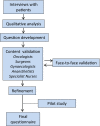Persistent perineal morbidity is common following abdominoperineal excision for rectal cancer
- PMID: 26245948
- PMCID: PMC4624814
- DOI: 10.1007/s00384-015-2328-1
Persistent perineal morbidity is common following abdominoperineal excision for rectal cancer
Abstract
Purpose: Short-term complications related to the perineal wound after abdominoperineal excision (APE) are a well-known problem. Perineal morbidity in the longer term is an almost unexplored area. The aim of this cross-sectional study was to investigate the prevalence of perineal symptoms 3 years after APE for rectal cancer, to identify potential risk factors and to explore the relationship between perineal morbidity and global quality of life.
Method: All patients who underwent APE in Sweden between 2007 and 2009 (n = 1373) were identified through the Swedish Colorectal Cancer Registry. Surviving patients were contacted 3 years after surgery and asked about participation. A total of 545 patients completed a detailed questionnaire. Clinical data was collected from the registry and surgical charts.
Results: Perineal symptoms occurred in 50 % of all patients 3 years after APE and more frequently in women (58 vs. 44 %; p = 0.001). Delayed healing of the perineal wound (>4 weeks) occurred in 25 % of all patients and more frequently after extralevator APE (ELAPE) than after conventional APE (32 vs. 11 %, p < 0.001). Delayed healing was associated with an increased risk of more severe perineal symptoms (relative risk (RR) 1.50, 95 % confidence interval (95 % CI) 1.09-2.05). Patients with more severe perineal symptoms (n = 129) had a significantly lower global quality of life as measured by EQ-5D visual analogue scale (VAS; median 75 vs. 83 points on the 100-point scale; p < 0.001).
Conclusion: Persistent perineal symptoms are common after APE and may have an impact on patients' quality of life. Delayed wound healing may be a risk factor for persistent symptoms. Further studies are needed to identify avoidable clinical factors for the development of persistent perineal morbidity. CLINICALTRIALS.
Gov identifier: NCT01296984.
Keywords: Abdominoperineal excision; Perineal morbidity; Quality of life; Rectal cancer.
Figures
References
-
- Asplund D, Heath J, Gonzalez E, et al. Self-reported quality of life and functional outcome in patients with rectal cancer—QoLiRECT. Dan Med J. 2014;61:A4841. - PubMed
Publication types
MeSH terms
Associated data
LinkOut - more resources
Full Text Sources
Other Literature Sources
Medical
Research Materials
Miscellaneous



